Defending 1v1 with Fikayo TOMORI
was roast dinners man madders the main man
This week, a clip of a training practice England worked on during the international break went rounds, involving Italian Serie A champion Fikayo Tomori and on form “roast dinner” entertainer James Maddison.
Let’s have a closer look at some of the key features of Tomori’s defensive sequence vs James Maddison.
Also, a word on
Explaining the purpose of the training drill
Explaining the difference between linear / non-linear learning
1. WHAT IS IT ABOUT? 🏴 👣 🩰
In player development there's two boxes to tick:
The WHAT / HOW
WHAT (the success criteria): scorekeeping, prevent the goal being scored. This is a result-based reading of the situation. Use all permitted means to reach that end
HOW (the execution criteria): covers the coaching points. Players develop at every age, but there’s obvioulsly a point where top end talent translated whatever “talent” they had in ability, to handle a set of situations in a repeatably consistent way (to give them more chances to be efficient down the line)
Stay dynamic on toes
Shoulders over feet
Feet narrower than shoulders
Eyes on the prize
So that it becomes second nature, having to adapt to an ever changing picture.
It is believed that execution is meant to lead to success, if timed properlu.
It’s possible to have a sligthly different approach to 1v1 defending, as football is ultimately a result-based sport (with no aesthetics score like dance).
Other parameters get into play to explain these variations, such as the environment players nurtured their craft (wouldn’t want to tackle on concrete would you).
An example highlighted by Joel from
A lunging “standing tackle” like a chameleon, with the sheer self-confidence in his own ability to read and snap to nick the ball.
The line between getting people off their seat, or groan is extremely thin here.


The outlook is different but ultimately, most of the “execution criteria” overlap.
Toes, staying dynamic and ready to “spring” with the body balance leaning forward (as opposed as back).
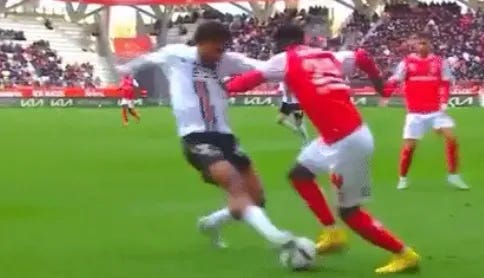
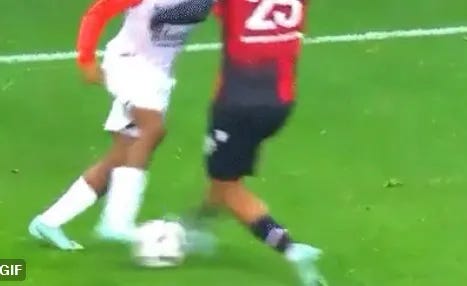
Cosplaying Mr. Wobblyman (from Noddy in Toyland), when feet are apart, body angle generally square and weight leaning backwards; gives a much lesser chance to succeed at these 1v1 situations.


The drill: what, why, how and when?
WHAT: Organisation
The exact detail of the drill isn’t captured on the videos, maybe it’s 3v3.
Best guess is: 2+1v2+1.
In other words: 2v2, and when defenders get it back they can play to the player 1v1 upfront, with one attacker coming in support (and one defender joining back with a delay to defend).
Dimensions are two (penalty) boxes on top of the other, with two goalkeepers.
WHY: Physical demand
There’s an introduction to the different type of training drills in the “Poch BOX” which you can read below.
There’s always a physical component.
Strength requires a lot of: start/stop, maintaining posture, lowering legs and block the occasional shot (or shoot).
Any 1v1, 2v2, 3v3 practice is perfectly suited to answer the demands.
As opposed to gym work to lift a Toyota Prius indoors; players do run during these practices, and unconsciously strenghen muscles at a deeper level (sometimes harder to reach specifially on machines).
Which makes it contextualised football training.
Tomori, moments earlier, “jockeying” perfectly against Jack Grealish:
inviting him outside (on his weaker left foot) and forcing a difficult cutback (that probably should’ve been handled better by Kalvin Phillips)
No need to train players with plastic ladders to dig trenches and irk groundsmen.
Lifting a Multi-Purpose Vehicle doesn’t make one a good 1v1 defender.
But being a good 1v1 defender means the player displays the “ability” to use his “physical capabilities” / “talent” to good use (preventing goals).
No matter how “muscular” he looks.
Nothing funnier than a CB with a muscular upper body, a look enhanced by modern-day tight jerseys; getting knocked over the ball every other shoulder-shoulder barge.
WHY: Psychological demand
Lots of big words, but that can be simplified with: country’s best defenders facing country’s best attackers, who comes out on top.
Granted the “physical demand” is relevant (when / how much at which point of the week), footballers don’t need to be put through galaxy brain practices.
Confidence building stuff if you can get past or put a stop to them.
2. DEFENSIVE MOMENTS 🏴 👣 🩰
📨 Quick tidbit from this from the (2023 Golden Boy finalist) Lucas Gourna newsletter:
Three steps of defending
Sprint to squeeze in
Slow down momentum
The defensive intervention in itself: footwork (and arms) to intervene at the right moment (or force backwards)
3. TOMORI’S DEFENDING STAGES
Back to Oluwafikayomi Oluwadamilola's defending (we zoom in on his name too)
1. Sprint to squeeze in
2. Stop momentum (hence heel first and balance backwards)
3. Defensive posture (points listed above)
4... ideally set before the attacker’s first/second touch to keep up, but not after.
Most “bad defending” stems from poor reading of the play (or lack of pace to squeeze in, or both), and doing everything one stage too late: such as slowing down when the attacker is already shifting it (that’s why defenders fall on their arse)
4. WHY NARROW STEPS 🏴 👣 🩰
yes, why, bigger steps = bigger distance?
The point is to be able to adjust to what the attacker does.
Therefore land the leg as soon as possible, to push in the other direction.
Landing too far exposes to: being nutmegged, and not being able to reach too far if you’re doing the splits.
Right leg to block. This is a choice, and this makes sense in the context of high level: top attackers are expert at pulling off shots with very little run-in.
You’d want to avoid the shot going off and deflecting over the left shinpad half a yard, because the bounce could create an unfortunate own goal.
Left leg bent low to block a nutmeg is quality too, as long as the player is “strong” enough to sustain his posture with the right leg, even for a split second.
Good stuff, shoulders forward for balance.
5. DON’T BE SQUARE 🏴 👣 🩰
This is like two magnets 🧲 🧲
See the immediate reaction from being on toes... but square (back to his goal), which is the posture you’d want to sprint laterally... ↔️
To being square with an angle means he's ready to
a. Lunge any leg
b. Run up or down if needed ↕️ which is what the defending situation demands
And always ON TOES 🩰
6. BE STRONG 🏴 👣 🩰
The drill’s physical demand here is STRENGTH: you want to develop footballers on the grass 🏋♂️, backed up with gym work if needed
(and not the other way round)
-Push with the right leg (🍖👀)
-Push with the left leg (🍖👀)
-Lunges right for a block (very close to the ball to prevent the shot going off and deflect). The leg is not completely lose, so could make a strong block. Also because the feet faces the ball.
Lunging with the tip of the foot with a stretched leg would be a very bad perspective from a knee-twisting perspective, to put it that way.
7. ADAPTATION 🏴 👣 🩰
That's why non-linear learning (=ABACBA... 🎲)
as opposed to AABBCC 📃 ...is preferable to develop footballers.
That’s how footballers trained in the middle of last century
AABBCC
(before football coaches, there was track field coaches, and before that military instructors).
The (now outdated - as proved wrong by most recent research) method was to train each aspect separately in a very cartesian/silo approach,
…because it would magically come together in games. Spoiler: it would not
“Get bumped by a plank” (this one cracks me up)
“Jump a ladder through a door”
“head a medecine ball in a door hinge”
then you’d be supposed to be able to score a header, whilst challenged by a defender after jumping to avoid a tackle during a game.
Challenging the good old : correlation isn’t causation.
Players need to adapt in real time.
By playing 1v1 duels that are chaotic whithin boundaries (pitch dimensions and laws of the game), players call upon a variety of answers tidbits to solve the ever changing problem they’re facing.
Practice makes better, some players are obviously quicker at grasping what works. Not all 10.000 hours are worthwile if that’s garbage hours.
The subsequent feline didn’t require 10.000 hours or attempts at figuring out that, as tap water can be hot, better show some care.
By facing similar, but never identical situations, which the chaotic 1v1 practice generates:
As football is a complex system - unlike, say chess, the brain makes his own salad out of everything it perceived and felt. Mixing tidbits of previous good/bad practices that make a “library” of experiences to rely on.
did that
stopped goal (or did not)
filled with happiness - or utter gut churning sentiment
Let’s try to do the same / different the next time round.
Good thing the training drill is desiged with “propensity” in mind.
“…design practices in which the coach’s desired behaviours/actions appear frequently”
No need to refer to : Page 3 §2.1, put one foot in front of the other
Last time you sat on the hotplate before checking, you burned your posterior.
Last time you defended feet apart, flat footed, you got nutmegged and teased for a week all over social media.
Takes longer to sink in with some than others mind.
-Tomori ready to block with his right leg
-Another feint means re-adaptation; land the right (to continue “jockeying”)
-🍖 👀
- most players would land the foot flat after a push with the (left) leg.
Tomori’s still on toes
8. STAY CONSISTENT 🏴 👣 🩰
this is a challenge to find out who's the first to fall apart
Another good string of moves by Oluwafikayomi Oluwadamilola
-Lunge to block
-Land (albeit a tad wide, and the way the foot is planted doesn’t allow him to set himself with an angle)
-It takes Tomori a split second to get back to default defensive posture with an angle - not having his back to the byline/goal
-Dynamic on toes, narrower than shoulders over feet… and all the jazz
9. TWO MORE MOVES 🏴 👣 🩰
Tomori displays two more “tools” or “moves” if you like, to handle the situation
Feels he's gotten into Maddison's personal space and that a standing tackle could make sense (his left looks like it could reach the ball)
seconds later: the stuttering (Right Right hops) is a good way to adjust to squeeze in (keeping the same posture, saving steps)
Can’t hop with the heels on the grass, or with lead shoes, can you?
10. DON’T BE WASHED UP 🏴 👣 🩰
Thighs start to heat at this point 🍖🔥
Most washed up (unfit/bad) defenders are on heels waiting for mercy.
The most talented con-artists throw a cinematic tackle one yard away to get beaten on purpose and be like “I did my best” (actually: spare me plz, or CBA )
Defending is an art, so is fake defending.
Tomori still covers ground with 4 hops to force Maddison into making a decision and disrupting his reading of the situation.

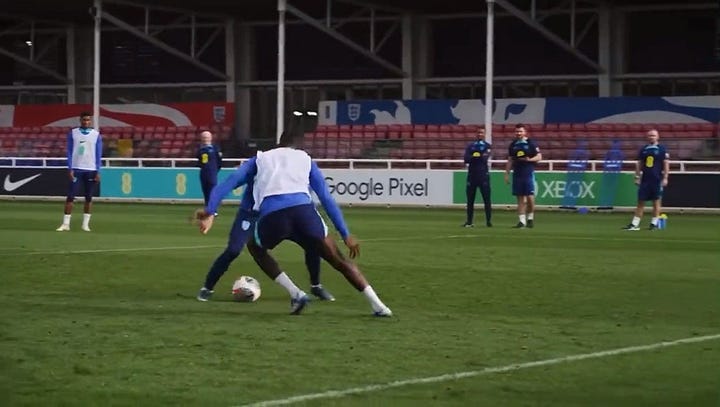
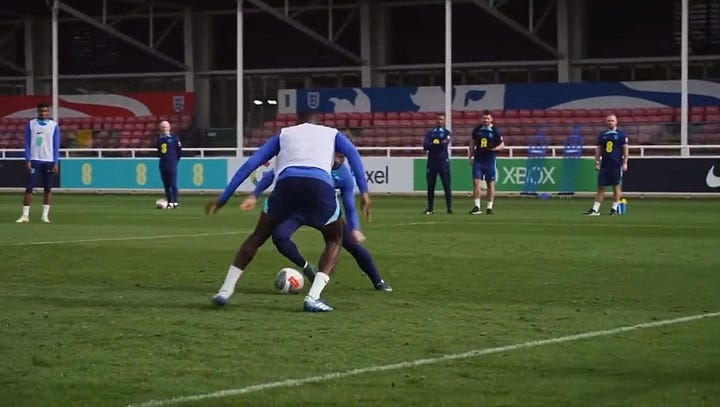
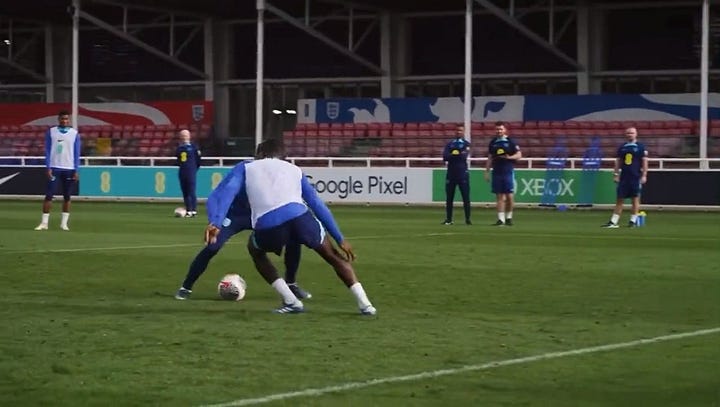
11. DDDDDDDON'T 🏴 👣 🩰
"Madders" has gone for the roast, he's definitely the main man.
With yet another feint, he finally forces Tomori to go to ground
Tomori goes back to his feet in a split second
Don’t be fooled, Tomori’s reaction here is still fairly impressive to “spring” back up
but "Madders" has finally created his yard separation and can go for it.
FINISHING SKILL
Side note on goalkeepers.
Usually attackers look in succession
🥅👀 goal (and "draft" a decision)
🦶👀 their feet
🥅👀 goal
GKs need to change the picture BETWEEN the two scans, squeeze in space
So that on the second time players look up, the picture has changed (and they’d normally be forced to make a new decision.
Most usually stick with the initial one and people in the stands complain that he shot straight at the goalie
Maddison doesn't scan *at all* therefore can't adjust to shoot where the GK *is not* 🙃
Agüero notably never looked at the goal whatsoever, but because he knew that he would create a yard whatsoever, and the way he’d hit the ball (sligthly laces/outside) would beat goalkeepers at the near post, far post at weird “low xG” angles regardless.
How to use that thread? 🏴 👣 🩰

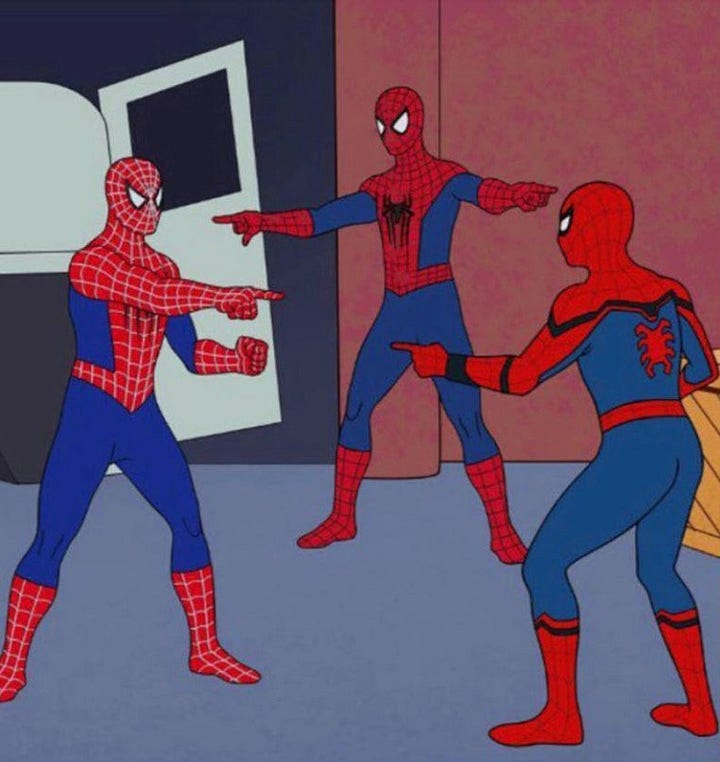
Build a mental framework of every point listed here
So you can spot the odd aspect out when watching a player
The brain has it’s own ways to produce that ick.
Expertise is about being able to recognize that small spark.
Then adress what's wrong, using any mean necessary: demonstration, explanation, video feedback etc…
That’s a parallel with driving lessons. You’re told to keep hands on the wheel at 9:15 or 10:10 on the hour clock, not cross hands and look where you’re going.
This looks dumb/simple-ish yet it works.
🚙"Look where you drive the car"
🔄Body/arms/hands turns the steering wheel accordingly
🤓Don't need to know and compute the angle ° radius
Defenders don’t need to hear that they need to jockey at 3.47 Hertz.
“go lower” “quick feet” “stay dynamic”
Can then be backed with video feedback (or real time feedback during a break).
A take:
Everyone had his take on this sequence.
“perfect” (@twitter_user1), “actually bad” (@twitter_user2)
For what it’s worth, I think Tomori does well, so does Maddison.
Maddison is probably there to have a bit of fun, would probably shoot earlier in a real game situation.
Tomori’s footwork is quality from a technical point of view.
I never like to use % as in “90% training intensity” because only a game environment pushes players to their limit.
But that would be something like that. Close to 90% training maximum, which is not 90% game maximum which isn’t 100% game maximum.
In other words, in a game situation there’d be less beating around the bush, and more arms in the face or getting stuck in.
It’s possible he sort of acknowledges Maddison’s “challenge” here, as there’s also little chance he’d (accept to) be ragdolled against an unknown attacker in a game situation.















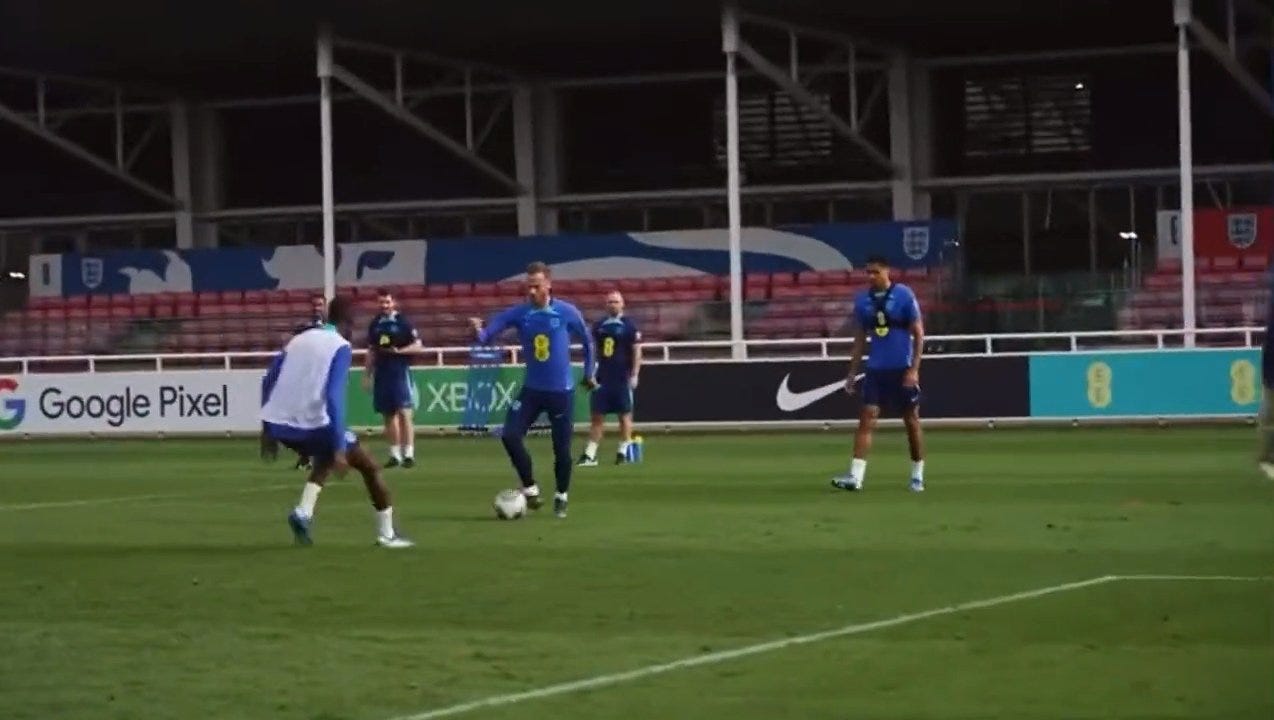
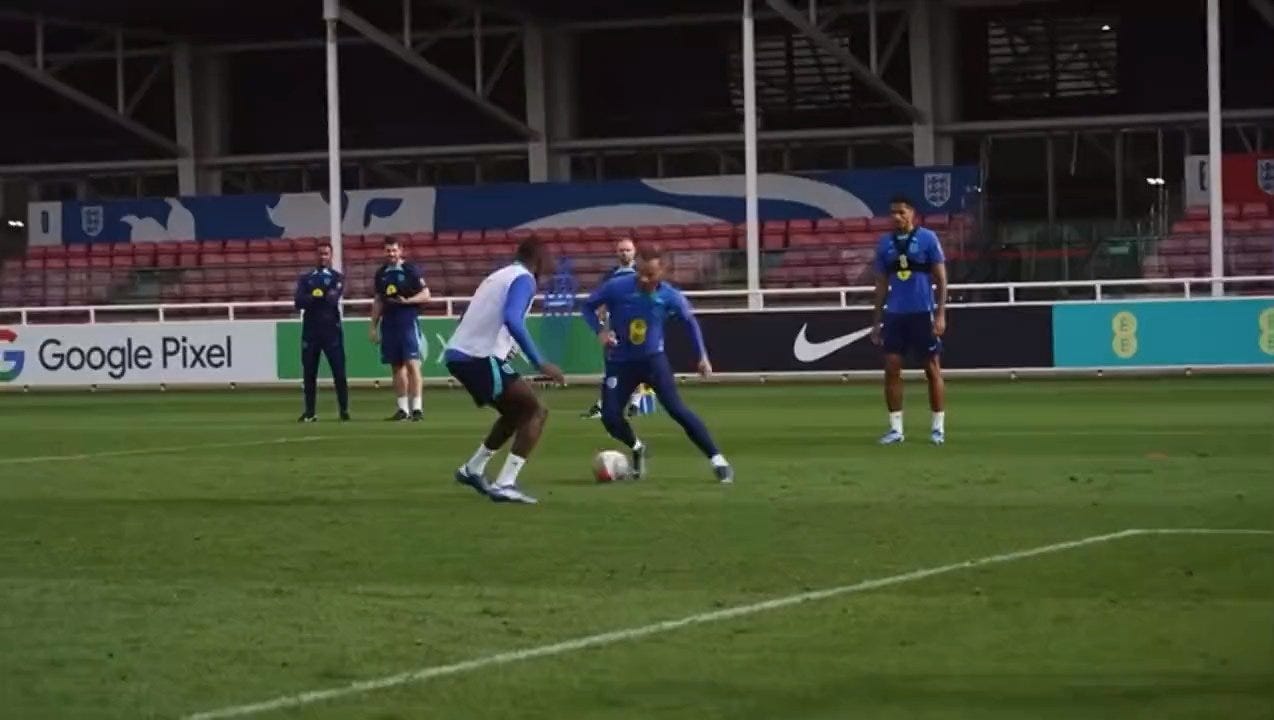

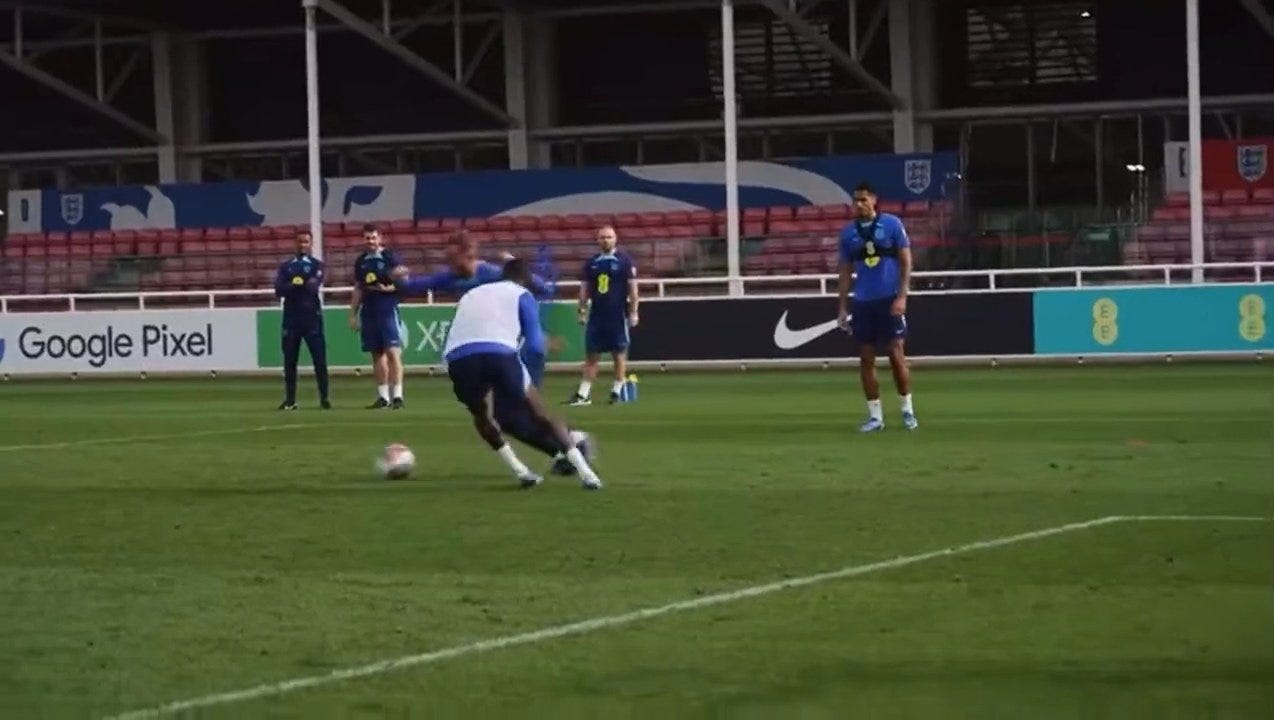

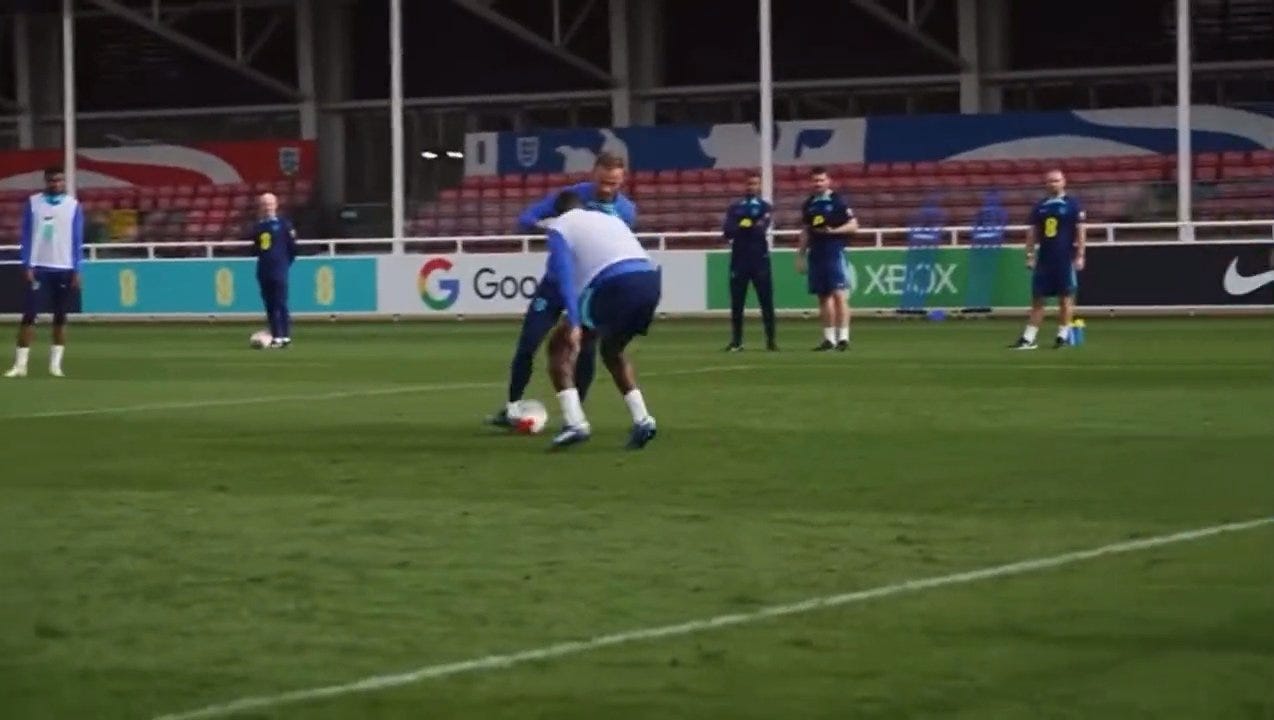
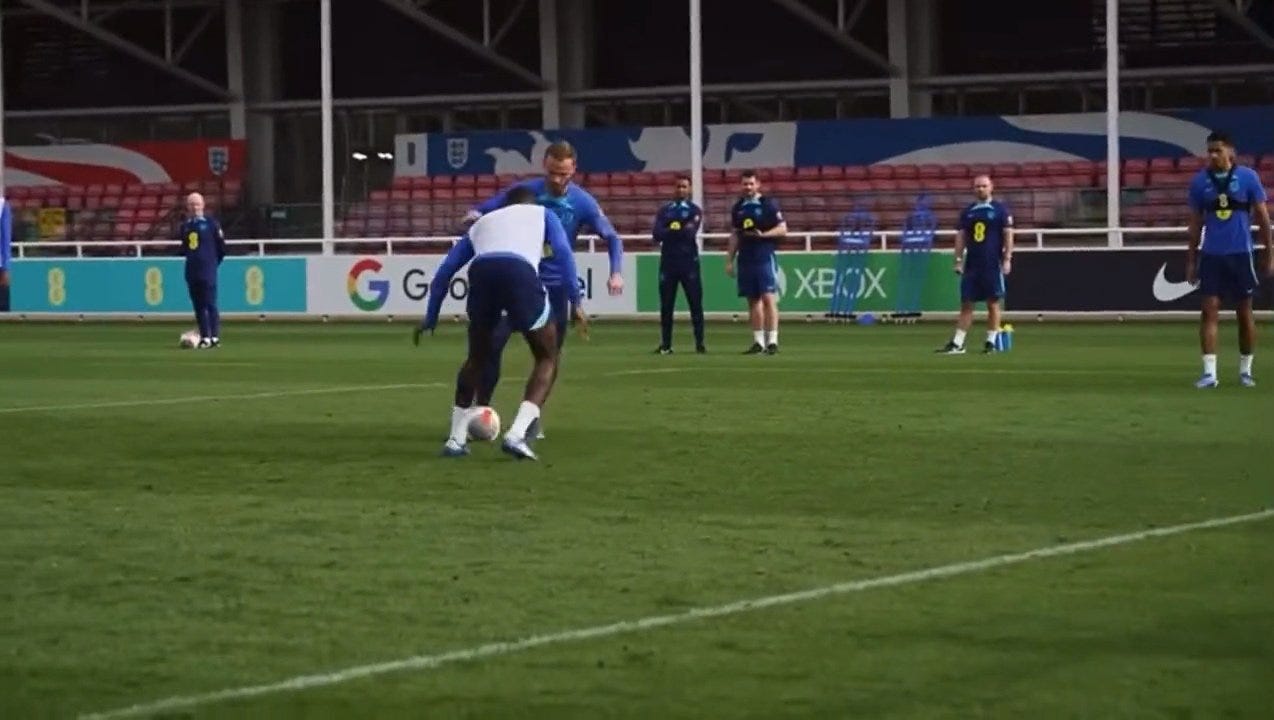
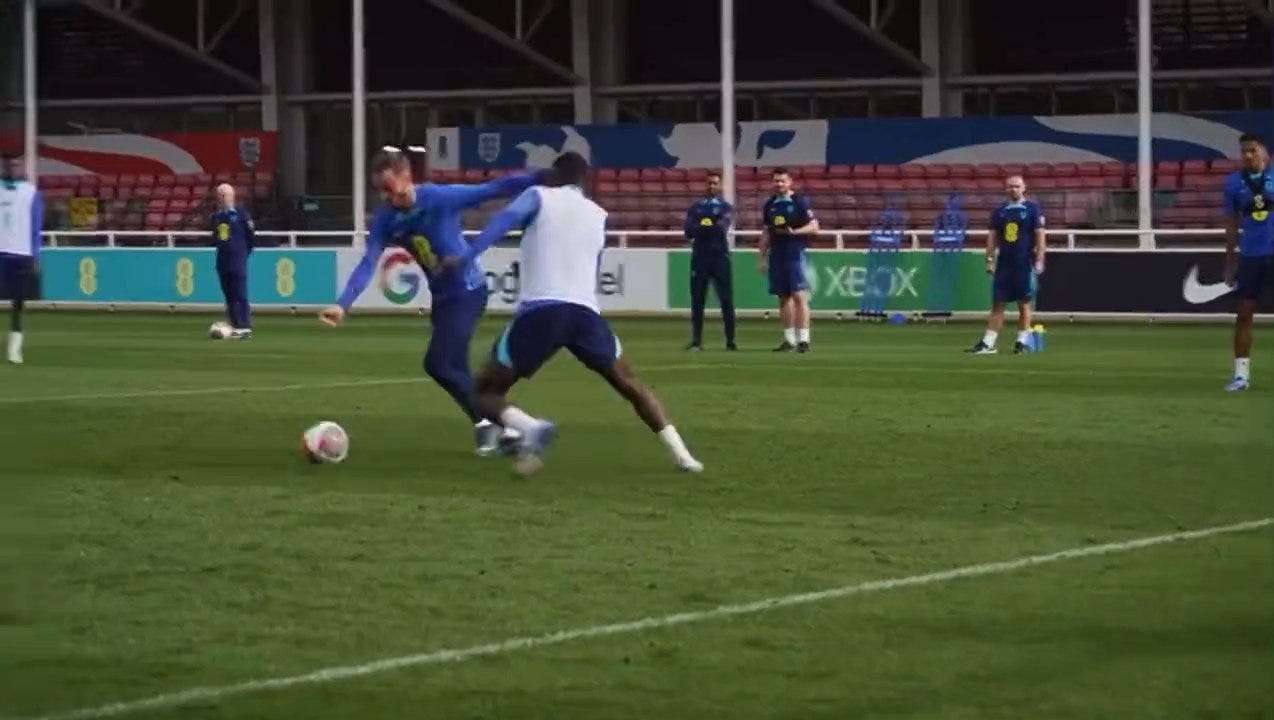
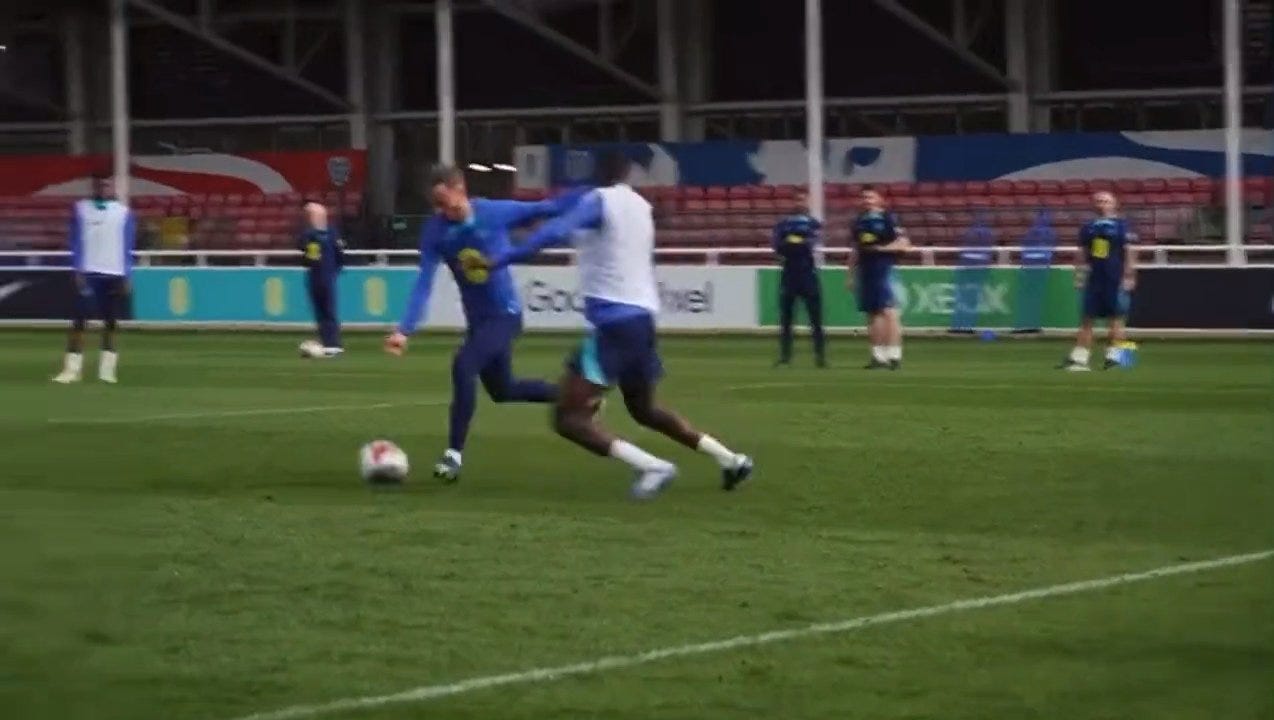






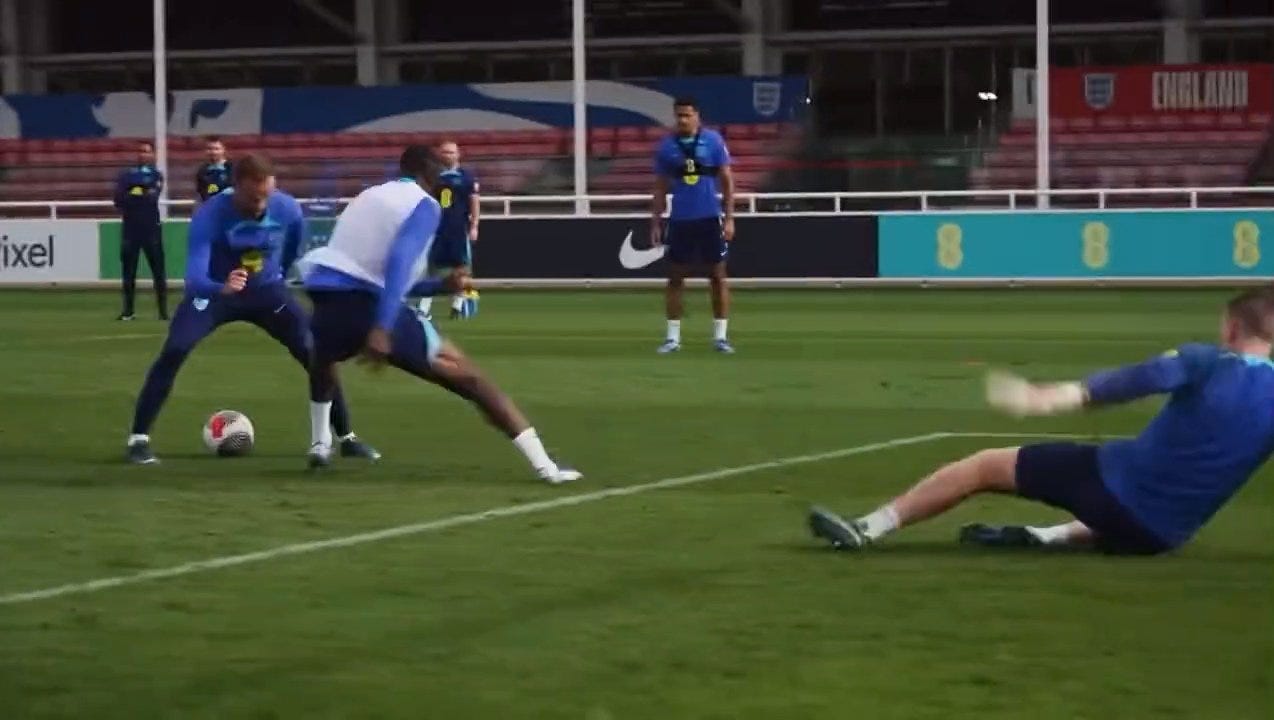

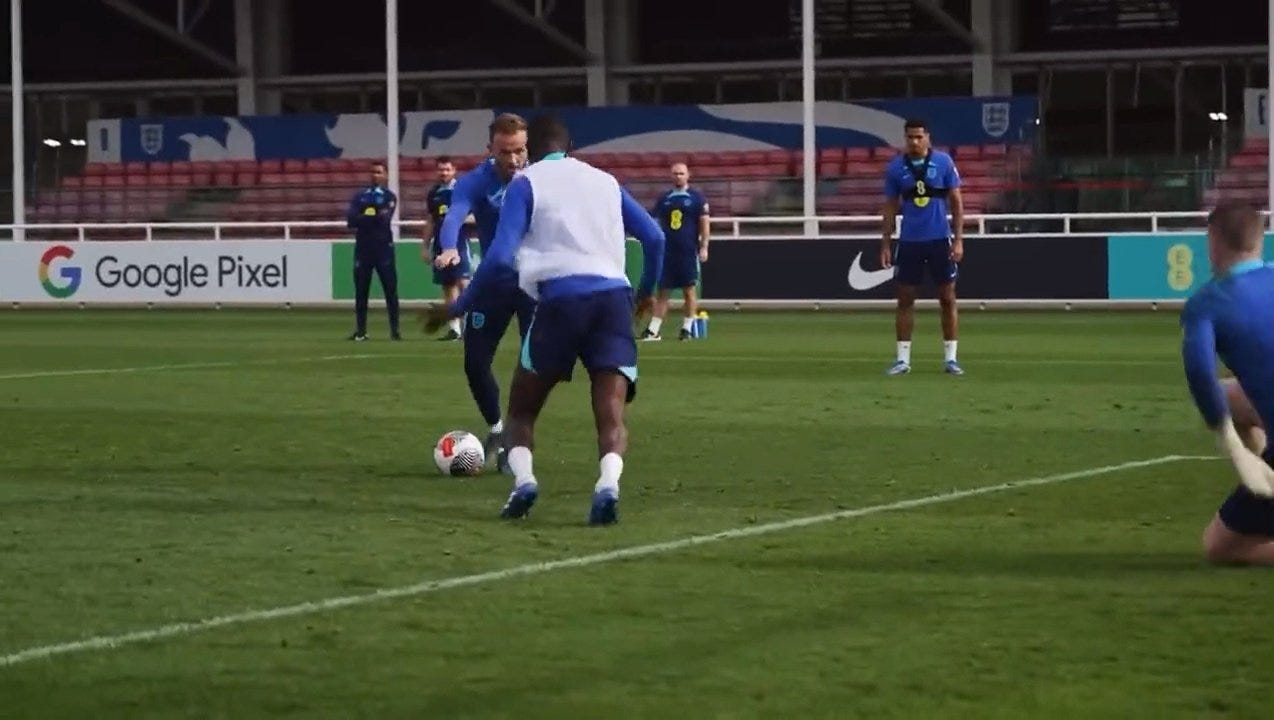
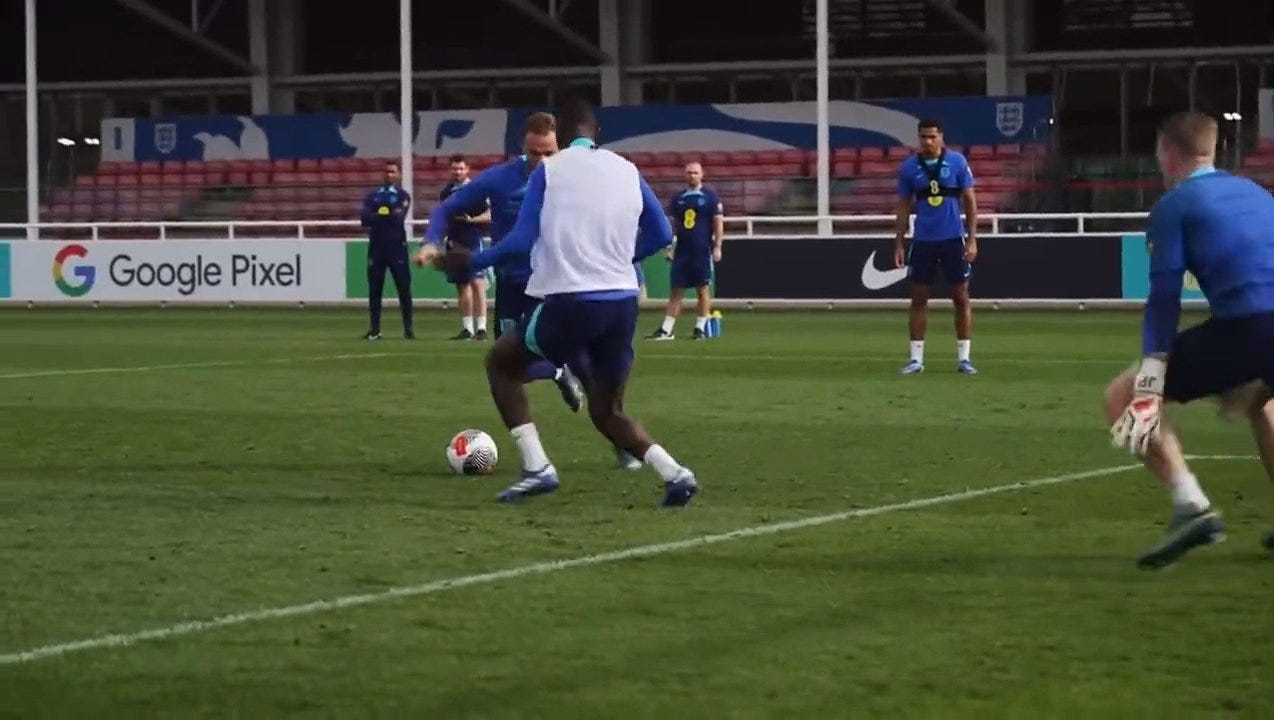
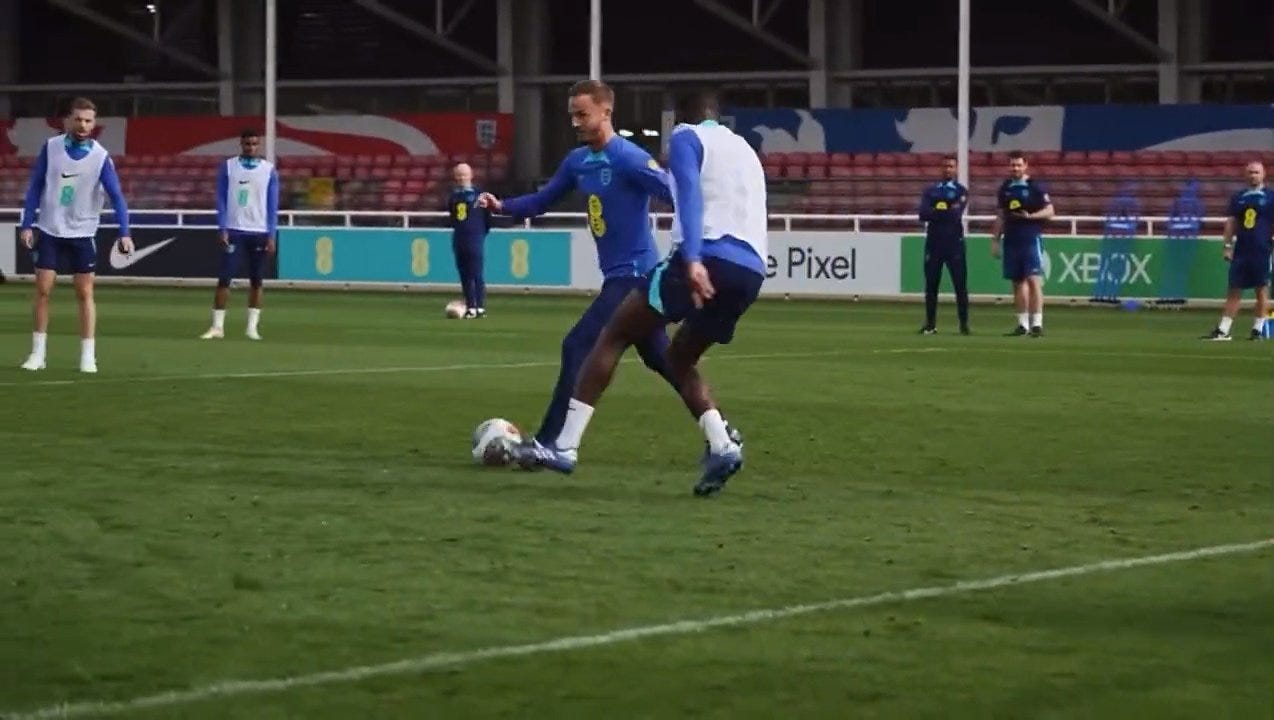
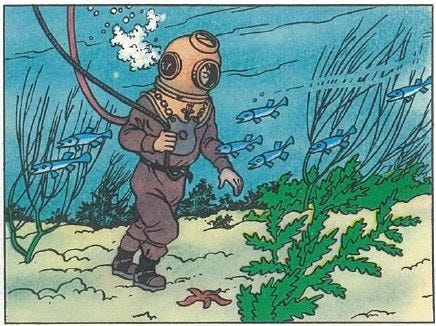
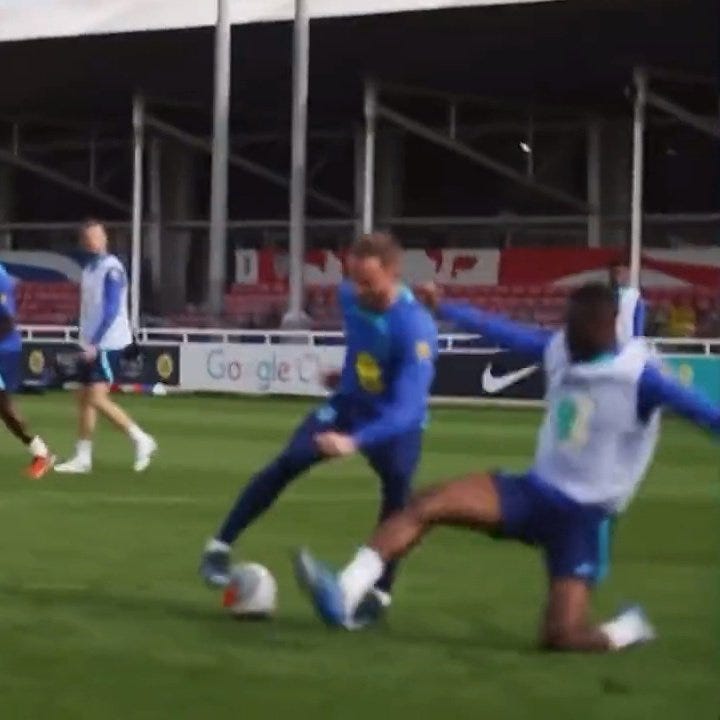

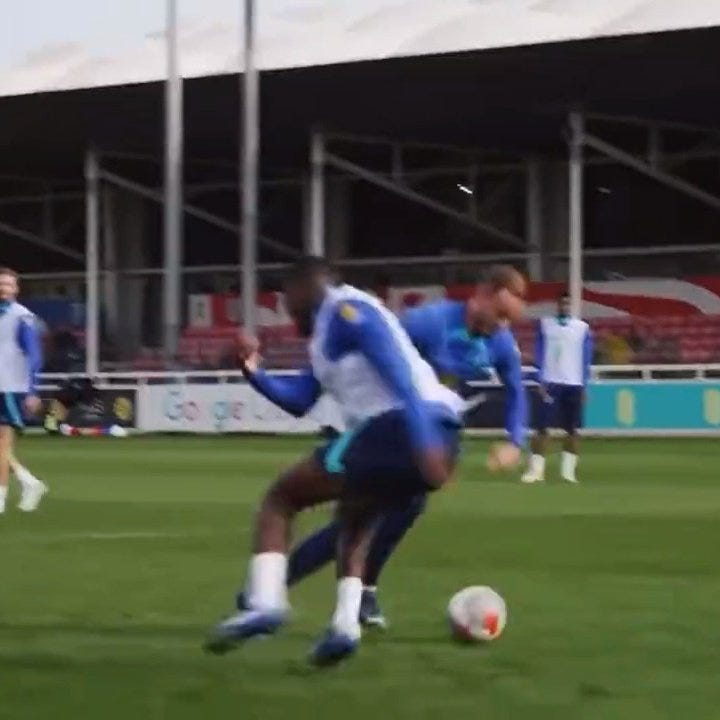


amazingly introspective as ever Seb, thank you for lowering the gates on actual real coaching points.
Hi mate do you have any knowledge on what pro teams do in the gym on a weekly basis? (Was reading the tuchel piece but couldnt comment there). Thanks